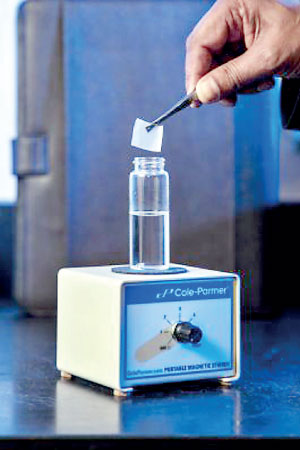Sunday Apr 20, 2025
Sunday Apr 20, 2025
Wednesday, 14 June 2017 00:36 - - {{hitsCtrl.values.hits}}
Scientists have found a quick and reliable way to test the freshness of the fruit in your grocer’s produce section. It all starts with a small strip of coated fabric developed at Florida International University (FIU).
The research, published recently in the ‘Journal of Chromatography A’, showed the coated fabric can soak up the chemical compounds in the juice of an orange that show the ripeness – or freshness – of the fruit.
The coating used on the fabric was invented by FIU Provost and Executive Vice President Kenneth G. Furton and chemistry researcher Abuzar Kabir who are co-authors of the study.
Analytical chemists by trade, Furton and Kabir initially pioneered the coated fabric to test blood, urine and environmental samples. They became curious about fruit because they wanted to see whether their coated fabric could provide the sensitivity required to pick up changes in the compounds that are used to detect the ripening cycle of fruits.
 “Everyone likes to advertise that they have the freshest fruit, but how long has that orange been sitting there?” Kabir said. “We used the orange as a model, and now, we can use this method to test the freshness of other fruit or any food that has a potential to degrade.”
“Everyone likes to advertise that they have the freshest fruit, but how long has that orange been sitting there?” Kabir said. “We used the orange as a model, and now, we can use this method to test the freshness of other fruit or any food that has a potential to degrade.”
After immersing the coated fabric into a small amount of the fruit juice, researchers quickly isolated the three main compounds within the fruit that are markers for freshness. Over a two-month period, they found these chemicals lost their intensity, indicating the ability to track the degradation of the fruit.
“Because oranges have high juice content,” Furton said, “they are more prone to spoiling and changes in its freshness impacts the quality and taste of their juices.”
The product could be an ideal solution for government inspectors, grocers, and even restaurants who order large quantities of produce. Determining the freshness of a batch of fruit quickly could be a long-term cost saver.
“Growers may also use this method to decide how quickly they need to get their crop to market or to use packaging that might slow the ripening process in order to keep fruit from reaching their peak before you buy them,” Kabir said. (Source: news.fiu.edu)
Discover Kapruka, the leading online shopping platform in Sri Lanka, where you can conveniently send Gifts and Flowers to your loved ones for any event including Valentine ’s Day. Explore a wide range of popular Shopping Categories on Kapruka, including Toys, Groceries, Electronics, Birthday Cakes, Fruits, Chocolates, Flower Bouquets, Clothing, Watches, Lingerie, Gift Sets and Jewellery. Also if you’re interested in selling with Kapruka, Partner Central by Kapruka is the best solution to start with. Moreover, through Kapruka Global Shop, you can also enjoy the convenience of purchasing products from renowned platforms like Amazon and eBay and have them delivered to Sri Lanka.
Discover Kapruka, the leading online shopping platform in Sri Lanka, where you can conveniently send Gifts and Flowers to your loved ones for any event including Valentine ’s Day. Explore a wide range of popular Shopping Categories on Kapruka, including Toys, Groceries, Electronics, Birthday Cakes, Fruits, Chocolates, Flower Bouquets, Clothing, Watches, Lingerie, Gift Sets and Jewellery. Also if you’re interested in selling with Kapruka, Partner Central by Kapruka is the best solution to start with. Moreover, through Kapruka Global Shop, you can also enjoy the convenience of purchasing products from renowned platforms like Amazon and eBay and have them delivered to Sri Lanka.